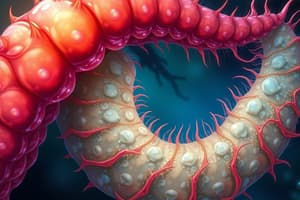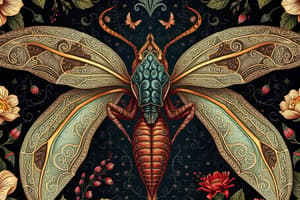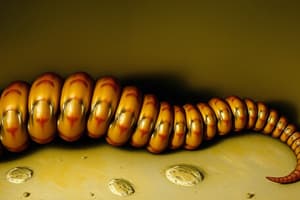Podcast
Questions and Answers
What is the primary characteristic of cestodes mentioned in the content?
What is the primary characteristic of cestodes mentioned in the content?
- They utilize a single host for their entire life cycle.
- They have a segmented body.
- They are exclusively found in aquatic environments.
- They bear a linear series of reproductive units called proglottids. (correct)
Which of the following is true about the reproductive traits of most cestodes?
Which of the following is true about the reproductive traits of most cestodes?
- They are hermaphroditic and often require multiple hosts. (correct)
- They require only one host for reproduction.
- They are dioecious organisms.
- They reproduce asexually without the need for a host.
What is an example of a cestode mentioned in the content?
What is an example of a cestode mentioned in the content?
- Ascaris lumbricoides
- Schistosoma mansoni
- Echinococcus granulosus
- Taenia saginata (correct)
Where does Taenia saginata primarily live as an adult?
Where does Taenia saginata primarily live as an adult?
What structure is composed of a linear series of reproductive units in cestodes?
What structure is composed of a linear series of reproductive units in cestodes?
What is the function of the vasa efferentia in the male reproductive system?
What is the function of the vasa efferentia in the male reproductive system?
Which component directly connects multiple testes to the vas deferens?
Which component directly connects multiple testes to the vas deferens?
Which statement best describes the organization of the male reproductive system's testes?
Which statement best describes the organization of the male reproductive system's testes?
What does the vas deferens primarily do in the male reproductive system?
What does the vas deferens primarily do in the male reproductive system?
How are the testes connected to each other in the male reproductive system?
How are the testes connected to each other in the male reproductive system?
What components make up the excretory system described?
What components make up the excretory system described?
What structure continues from the excretory canals in the scolex?
What structure continues from the excretory canals in the scolex?
Which pair of excretory canals is mentioned as part of the system?
Which pair of excretory canals is mentioned as part of the system?
What is the primary function of flame cells in the excretory system?
What is the primary function of flame cells in the excretory system?
Where are the excretory canals located relative to the body form?
Where are the excretory canals located relative to the body form?
What role does the intermediate host play in the life cycle described?
What role does the intermediate host play in the life cycle described?
In which part of the reproductive system does fertilization occur?
In which part of the reproductive system does fertilization occur?
What is the outcome of the life cycle involving the essential host?
What is the outcome of the life cycle involving the essential host?
How many hosts are involved in the life cycle as described?
How many hosts are involved in the life cycle as described?
Which statement best describes the movement of sperm during fertilization?
Which statement best describes the movement of sperm during fertilization?
How long does it take for a mature tapeworm to develop in a human host?
How long does it take for a mature tapeworm to develop in a human host?
What happens to proglottids when a person is infected with a tapeworm?
What happens to proglottids when a person is infected with a tapeworm?
What is the primary consequence of being infected with one of these tapeworms?
What is the primary consequence of being infected with one of these tapeworms?
Which of the following accurately describes the lifecycle of a tapeworm in humans?
Which of the following accurately describes the lifecycle of a tapeworm in humans?
What is the significance of proglottids for a tapeworm’s reproduction?
What is the significance of proglottids for a tapeworm’s reproduction?
What happens to the egg shells after the cattle swallows the eggs or proglottides?
What happens to the egg shells after the cattle swallows the eggs or proglottides?
Where do the hexacanth embryos burrow after the cattle swallows the eggs?
Where do the hexacanth embryos burrow after the cattle swallows the eggs?
Which of the following best describes hexacanth embryos?
Which of the following best describes hexacanth embryos?
Which process initiates after cattle consume the eggs or proglottides?
Which process initiates after cattle consume the eggs or proglottides?
What role do blood or lymph vessels play in the life cycle of the hexacanth embryos?
What role do blood or lymph vessels play in the life cycle of the hexacanth embryos?
Flashcards
Cestodes
Cestodes
A type of flatworm with a segmented body.
Proglottids
Proglottids
Reproductive units in a cestode's body.
Hermaphrodite cestodes
Hermaphrodite cestodes
Cestodes with both male and female reproductive organs.
Taenia saginata
Taenia saginata
Signup and view all the flashcards
Two hosts
Two hosts
Signup and view all the flashcards
Flame cells
Flame cells
Signup and view all the flashcards
Excretory canals
Excretory canals
Signup and view all the flashcards
What connects flame cells to excretory canals?
What connects flame cells to excretory canals?
Signup and view all the flashcards
Excretory canals in scolex
Excretory canals in scolex
Signup and view all the flashcards
Dorsal and ventral excretory canals
Dorsal and ventral excretory canals
Signup and view all the flashcards
Male Reproductive System
Male Reproductive System
Signup and view all the flashcards
Vasa efferentia
Vasa efferentia
Signup and view all the flashcards
Vas deferens
Vas deferens
Signup and view all the flashcards
Ejaculatory Duct
Ejaculatory Duct
Signup and view all the flashcards
Cestode Life Cycle
Cestode Life Cycle
Signup and view all the flashcards
Intermediate Host
Intermediate Host
Signup and view all the flashcards
Essential Host
Essential Host
Signup and view all the flashcards
Fertilization in Cestodes
Fertilization in Cestodes
Signup and view all the flashcards
Why Two Hosts?
Why Two Hosts?
Signup and view all the flashcards
Hexacanth embryo
Hexacanth embryo
Signup and view all the flashcards
Intestinal wall
Intestinal wall
Signup and view all the flashcards
Blood or lymph vessels
Blood or lymph vessels
Signup and view all the flashcards
How does the hexacanth embryo reach the next host?
How does the hexacanth embryo reach the next host?
Signup and view all the flashcards
Cyst
Cyst
Signup and view all the flashcards
Tapeworm life cycle
Tapeworm life cycle
Signup and view all the flashcards
How long does it take for a mature tapeworm?
How long does it take for a mature tapeworm?
Signup and view all the flashcards
How do tapeworms reproduce?
How do tapeworms reproduce?
Signup and view all the flashcards
How many proglottids are expelled?
How many proglottids are expelled?
Signup and view all the flashcards
Study Notes
Platyhelminthes Subkingdom Metazoa
- Subkingdom: Metazoa
- Phylum: Platyhelminthes
- Classes: Turbellaria, Trematoda, Cestoda
Class Turbellaria
- Example: Planaria
- 1-Class
Class Trematoda
- Example: Fasciola
- 2-Class
Class Cestoda
- Example: Taenia
- 3-Class
Characteristics of Class Cestoda
- Endoparasites: Lack an alimentary canal
- Absorb nutrients through body surface
- Long flat worms: Composed of linear proglottids (reproductive units)
- Most are hermaphrodites: Require at least two hosts (e.g., Taenia saginata lives as adult in human intestines)
- Mature adult can reach 10-12 meters in length
- Can have 1000-2000 proglottids
Cestoda Body Regions
- Scolex: Bears hooks, suckers, or other attachment organs
- Neck: Narrow, unsegmented region followed by a linear series of proglottids (immature, mature, and gravid).
Life Cycle
- Complicated, involving one intermediate host and one essential host
- Intermediate host harbors larval stages
- Essential host harbors mature stages (sexual reproduction)
- Humans are an essential host for some tapeworm species
Excretory System
- Composed of flame cells attached to small canals leading to excretory canals
- Excretory canals in scolex continue along body
- Paired dorsolateral and ventrolateral excretory canals connected by transverse canals near posterior end of each proglottid
Reproductive System
- Hermaphrodites: Each proglottid has both male and female genital systems
- Male reproductive system: Numerous small testes connected to vasa efferentia, forming a single vas deferens that leads into a seminal vesicle and opens through a papilla-like penis.
- Female reproductive system: A large bilobed ovary connected to the oviduct, which unites with the vitelline duct to form an ootype. The uterus is branched in gravid proglottids, and filled with fertilized eggs.
Taenia Saginata
- A type of tapeworm
- Has a uterus (branched), testes, ova, and other relevant structures for reproduction
- Mentioned in life cycle descriptions
Studying That Suits You
Use AI to generate personalized quizzes and flashcards to suit your learning preferences.
Related Documents
Description
Explore the fascinating characteristics and life cycle of Class Cestoda, a group of flatworms under the subkingdom Metazoa. Learn about their structures, such as the scolex and proglottids, and their unique reproductive strategies. This quiz will test your knowledge on these endoparasitic organisms and their biological significance.




